Ten years ago, I couldn't have cared less if the new burger place downtown had a website. Now, I don't trust one that doesn't. If your business is online, you're a part of the digital transformation. But it's not enough these days to just "be online." Businesses that will thrive in 2021 that are operating online — and the COVID-19 pandemic has proved this.
Consumer buying behavior has drastically changed — today, most consumers are purchasing products online, including almost 70% of millennials. In 2019, nearly two-thirds of businesses ( 64% ) had a website. If you don't have one, you could be falling behind your online competition.
So, while it’s a great step to have a website and a Facebook page, there’s more to the transformation than just having an online presence — technology should be ever-present in all of your business operations. This piece will explore the digital transformation, why businesses are getting on board, and outline the roadmap for enacting one for your business. We’ll also give some real-life success stories from companies that have bought into the digital transformation.
Essentially, a digital transformation fundamentally changes how businesses provide value to their customers and streamline their processes. It’s a reminder that materials and processes your company uses during day-to-day operations, no matter how big or small, might need a new medium — technology. Let’s take a look at why this transformation exists in the first place, with particular reference to the present pandemic.
Why do businesses undergo a digital transformation?
Simply put, things are often easier when they’re online. New technology makes website building more accessible and creates more opportunities for businesses to connect with their audiences. A digital shift also saves time. You may already be using some methods of digital strategy, like Standard Operating Procedures (SOPs) , social media scheduling tools, and instant messaging apps; these are all examples of small digital transformations that replace paper instructions, outbound marketing, and an extra trip to your managers’ desk.
A shift to digital processes also makes it easier to conduct overall large-scale business tasks. For instance, online databases that sort and catalog customer information, and automation tools that take over day-to-day activities and allow employees to focus their efforts on more pressing tasks.
Customers have also begun to expect the businesses they interact with to have some sort of digital presence, whether it’s an optimized Google My Business profile for easy access to mapping instructions or an automated chatbot that can answer their questions over Facebook Messenger .
In addition, the COVID-19 pandemic has further proven and accelerated the need for businesses to get on board with a digital transformation. As companies around the world were forced to pivot to providing service online or at a distance from their customers, having digital tools at their disposal was, and is, critical to survival.
Many businesses have adopted different online practices during the pandemic, like providing digital customer service . It’s likely that, as a result of the pandemic and general trends, customers will expect that they’ll be able to conduct business online with their favorite brands.
70% of businesses today are finding that the digital shift is worth it, and these businesses either have a digital strategy in place, or are earnestly working towards one.
As a whole, 70% of businesses today are finding that the digital shift is worth it. These businesses either have a digital strategy in place or are earnestly working towards one. Whether you’re already one of these businesses or you’re hoping to begin your journey, let’s go over three critical questions that you can use as a roadmap for implementing your strategy.
Digital Transformation Strategy
Business leaders are faced with a variety of options for enacting a digital transformation. As technology becomes more commonplace, there are a significant number of tools to choose from. While it may be exciting (and overwhelming) to imagine all of the possible upgrades you can make to your business, a digital transformation strategy will help you become more focused.
This strategy is essentially a structured way to move through the process, how you get from point A (pre-transformation) to point B (post-transformation). Let’s go over some guiding questions and additional requirements to help you create a viable digital transformation strategy.
1. Why do we need a transformation?
Like all plans and strategies you’ve created for your business, designing your roadmap begins with identifying your purpose. You can start this process by uncovering the challenges your business faces that have significantly impacted success or processes that you feel may become easier with technology. This could be anything from day-to-day automation tasks like sending out email newsletters or more essential business needs like data collection and storage.
You may also be hoping to address multiple challenges at once. For example, say your business has had trouble handling customer service requests because you’re using different platforms to store customer data and communicate with customers. Reps may have difficulty accessing a client's history with your company because they need to sift through other records and jump between platforms to find the information they need. This takes time, and clients may report being frustrated by how long it takes to resolve their issues.
In this case, the answer to why do we need a transformation? is that your customer service team struggles to give customers the experiences they desire because of long wait times and a disorganized data storage system. Whatever your reasons are, identifying the challenges that expose the need for a digital transformation makes it easier to create further goals and metrics that will define your process’s success.
2. What do I need to achieve to transform?
As mentioned above, the challenges and pain points you’ve identified answer why you need to transform. Once you have this why, it becomes easier to figure out what needs to be done and what steps you need to take to overcome the challenges you’ve outlined.
Aim to come up with metrics or objectives you can use to guide yourself and your teams through this process, including workflows, identifying key stakeholders, and assigning critical tasks. If you have multiple pain points, come up with at least one objective or goal for each one of them.
When you identify these objectives, come up with a time frame in which they should be met to succeed in your transformation. Continuing with the previous example, your challenge is that reps don’t have access to a summary of client history. Your objective can be that, over the course of the year, you want a streamlined process for inputting and cataloging customer information and a less than one minute wait time for accessing customer records during service interactions. With this goal in mind, you know what you need to achieve to say that you’ve transformed your process. With this, it becomes easier to identify the tools that will assist you along the way.
3. What do I need to change to meet these goals?
The final question involves researching and identifying the technology you’ll need to successfully transform. Some of these may be middle-of-the-road tools that help you reach your end goal, while others may be the permanent solution you implement and use forever.
Using the same example as before, you’ll want to know the tools you’ll need to use to begin the process of transferring the data you already have into the tool that your representatives will use to access customer data within the timeframe you laid out. This could mean that your initial tool is a simple data integration platform that you’ll use to merge existing data from your different sources. After this, maybe you’ll need a sorting tool that catalogs and organizes data into business-relevant categories, and this data will be further integrated into a Customer Relationship Platform (CRM) that all of your representatives have access to during customer interactions.
4. Get company wide buy-in.
A digital transformation affects all areas of your business. Given this, it’s critical that you obtain company wide buy-in , from packing and fulfillment to C-Suite executives. You can’t just say “Okay we’re doing this!” and expect a seamless process, though. This is why this principle comes after the first three guiding questions — inspire buy-in using the understandings you’ve previously gathered.
One of the first things you should do is present teams with a clear why statement that explains the reasons your business needs to undergo a digital transformation. Along with the why statement, present a value proposition to explain the benefits the business (and employees) will obtain from this transformation. Maybe you can share sample projections you’ve come up with or a case study you’ve created based on market research and competitive analysis (which we’ll cover below).
Lastly, you should let them know that it’s an involved process. You’re not demanding that they get on board and deal with it — you want them to participate in the process. They can pose questions, offer suggestions, or simply ask about their new tasks.
5. Research industry and market competitors.
As with most new projects, it’s important to understand what your competitors are doing. Conducting a competitive analysis can help you do this, as you’ll generate a well-rounded picture of how they’re performing.
The results of your research will likely give you an understanding of how they do their business, if they’ve implemented and succeeded in a digital transformation, and uncover possible areas for your business to outperform them. It’s also important to conduct overall market research to understand what trends your industry is experiencing to understand how you compare, or as a means of inspiration to further guide your process.
6. Create a budget.
A digital transformation is a costly process, especially if it’s a complete overhaul of your current methods. Once you understand your purpose and outline how you’ll need to change, create a budget . This budget should address all possible expenses you’ll encounter throughout the process: software costs for transitional and permanent tools, any costs to hire new talent, employee training for new processes, and allocation of funds for any unexpected costs.
The unexpected costs section of your budget may be the most important, as a digital transformation is based on change. These changes are likely new, so you’ll want to be prepared if any issues arise from adaptation difficulties along the way.
7. Create a digital transformation roadmap.
Once you have all necessary information, the next step is to implement your strategy. Specifically, as mentioned above, how you’ll get from point A to point B. A digital transformation roadmap is the way to do this, and we’ll outline the steps below.
Digital Transformation Roadmap
After you’ve created your strategy, a detailed plan will guide you through implementation. HubSpot offers a free template that will help you schedule and work through a digital transformation roadmap, broken down into seven weeks.
Firstly, this template comes with a checklist that you can fill in with the information you’ve gathered while creating your strategy. You can input benefits, what you need to achieve to transform, the tools you’ll need to transform, and key stakeholders for your business. Having all information in one place makes it easier to refer back to a common document as you navigate through your process.
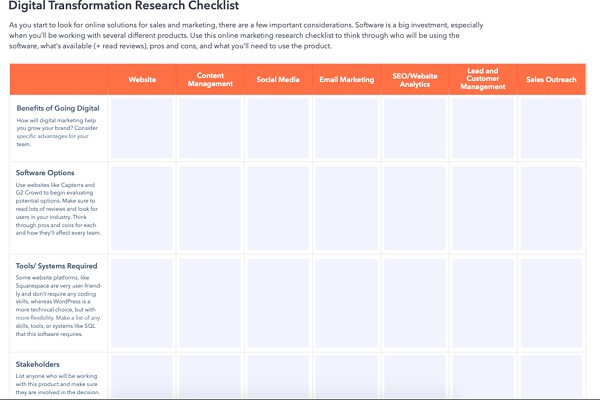
Week one is all about gathering existing sales and marketing materials on paper, while week two dives into transferring your business online, and so on. These small steps are designed to fit into your busy schedule and help you remain organized as you transition.
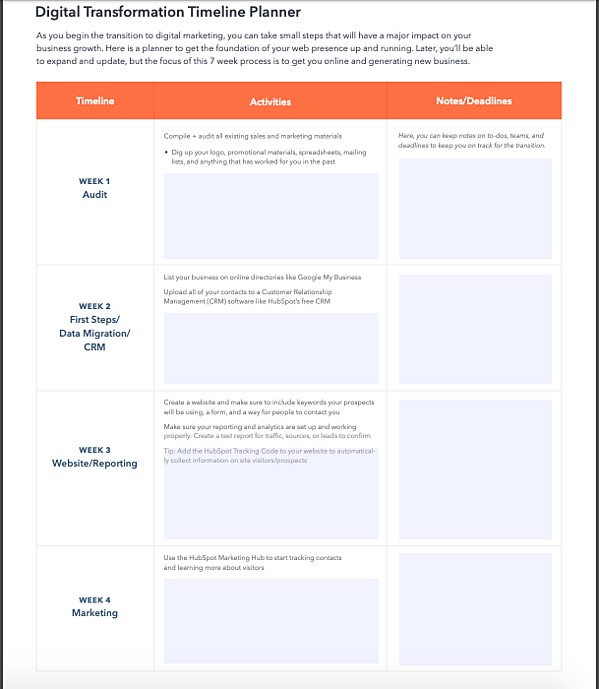
Week two is all about data migration. A free CRM, like HubSpot, can help you input business data, customer profiles, into an easy to access database.
During weeks three and four, you should have a functioning website and marketing resources that will help you learn more about your visitors and their behavior.
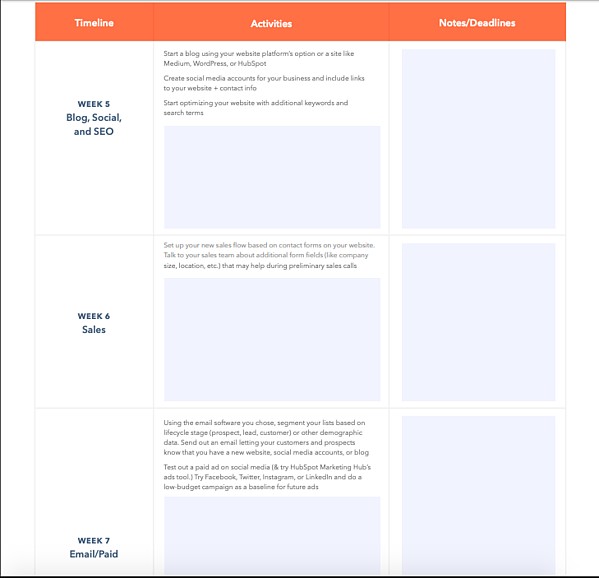
The latter half of the weekly plan ramps up your online presence. Using this template can help you organize your new digital shift by area to avoid doing one huge push all at once and confusing employees.
Creating a blog during week five will help you find your target audience online. Posts should be about your target market (if you're a tech marketing company, posts should center around the intersection between the two) to demonstrate your expertise. This will build your reputation as a thought leader in your industry.
By week six, you should set up a sales flow that will digitize your sales process. Online sales tools allow you to keep track of all your contacts, log your conversations, and keep tabs on-call schedules and upcoming meetings.
Email and paid ads should be rocking-and-rollin' by week seven. The email software you choose will help you through the process of sending automated emails to subscribers and let you test out paid ad software.
In a month and a half, most of your business processes will be digital.
Best of all, this template can be tailored to meet your business’ transformation individual needs and gives you the wiggle room to expand as your business continues to scale — but as a starting point, it gets you up and running.
Once you’ve created your digital roadmap, it becomes easier to go more in-depth into your processes and create a finalized list of the technology you’ll need to succeed in your transformation. Below, we’ll go over some popular digital transformation tools to consider using.
Digital Transformation Tools
Depending on your overall transformation goals, there are multiple platforms available to help you succeed and meet your objectives. However, there are various multipurpose tools that can benefit all types of businesses, and we’ll go over a few of them below.
1. Instant Messaging
Instead of having a meeting or a long email thread for a quick message, consider using a company-wide instant messaging tool for quick and easy communications. Some instant messaging services are made for corporate settings, like Slack or Flock .
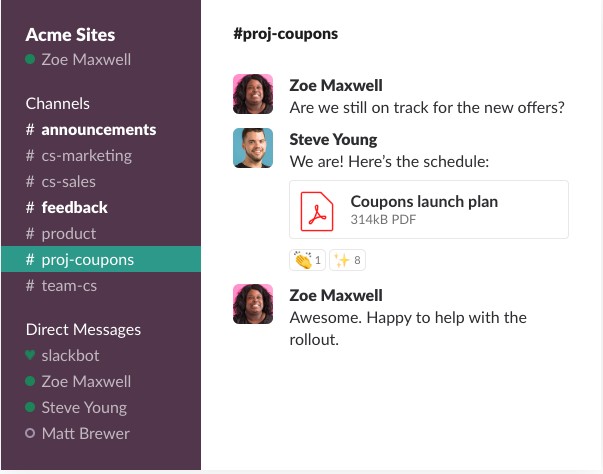
With these services, you can file share, direct message, and create channels where teams can collaborate and discuss projects. Think of it as the office water cooler — just online.
2. Application Tools
Are you looking for new talent? The best candidates (especially ones who prefer to work digitally) are online. For instance, LinkedIn, a site for professional networking, is an excellent source for recruiting candidates:
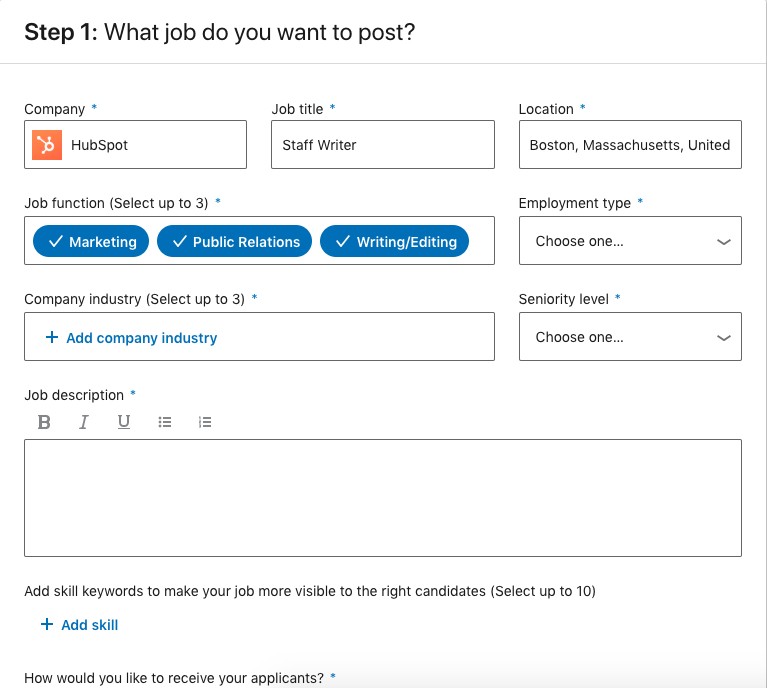
Using LinkedIn’s template will help you post a listing, and you can use LinkedIn’s industries function to ensure it’s shared with relevant candidates. LinkedIn will alert you of new entries and send you their applications, making the selection process an online breeze. This is an alternative to collecting application materials via email, where it might be difficult to structure, organize, and compile applications.
3. Sales Management
Software is available to help manage many facets of your business, including sales. This software enables you to manage calls, pipelines, reporting, and follow-up resources to help your process migrate smoothly online.
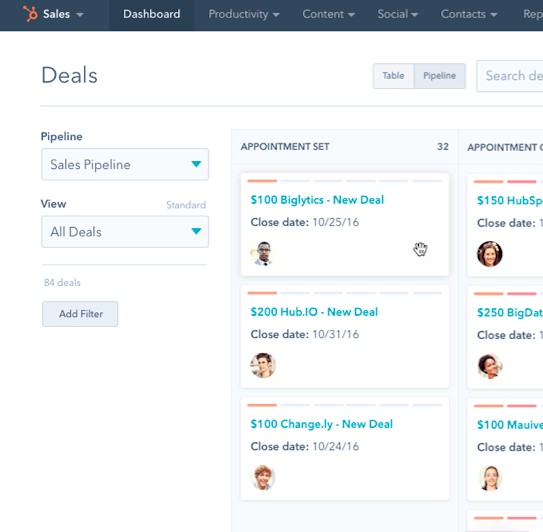
For instance, as shown above, HubSpot’s Sales Hub can be used to organize all of your sales materials online. Within the platform, you can manage deals, filter contacts, and create different tasks using a dashboard to help you keep track of your sales processes.
4. Standard Operating Procedures (SOPs)
If you have certain aspects of your day-to-day that require multiple steps typically written down on paper, transfer it online. This will reduce paper trail and make the processes shareable and accessible to all employees.
Online SOP software makes it easy to list procedures and job functions, which can be beneficial for onboarding and employee training. To make a smooth transition to your new digital tool, consider talking to employees and asking them to contribute and collaborate with you in the process. The image below is an example of a digital SOP workflow management tool by Process.st .
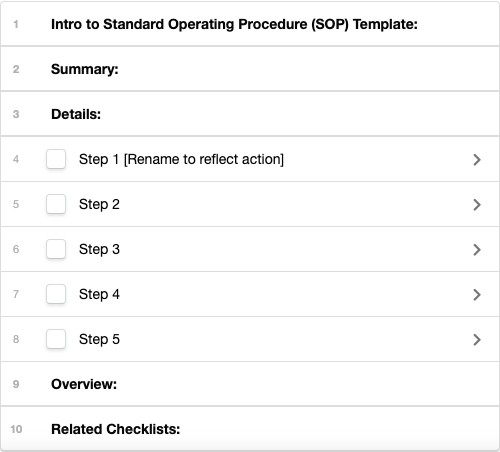
5. Customer Relationship Management (CRM) Software
A CRM is going to be your best friend when shifting to an all-digital business. Whether your goals are to transform the customer experience, streamline sales, or digitize your marketing process, a CRM will make these processes more straightforward and even automate repetitive tasks. HubSpot’s free CRM offers three hubs that give you an all-in-one business platform designed for scalable growth.
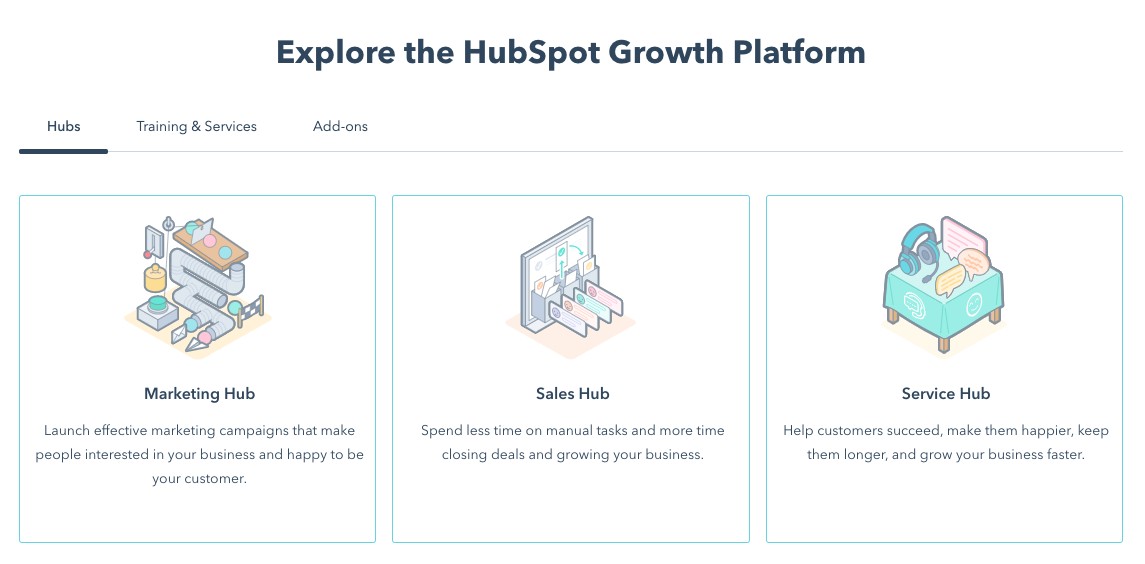
HubSpot's free CRM offers three hubs that give you an all-in-one business platform experience. From customer service reps to sales leaders and business owners, this free CRM helps you fully transfer your business online and drive growth.
6. Video Chat Software
Is your team out of town but you need to schedule a meeting? Are your representatives transitioning to a remote, work-from-home model but you still want to maintain a collaborative environment? Use video chat software to meet virtually and maintain employee connections.
Software like Skype for Business and Zoom offer free web-chatting services for professional use.

Skype has automatic subtitle settings and 1:1 capabilities, and the option to host multiple people on calls at once. Most software also has mobile applications to make sure you’re accessible and able to meet at any point during the workday.
Though these tools are designed to make your life easier, you may be confused about how they can apply to your business. Thankfully, many companies that are joining the digital revolution are doing so because they have similar needs. Below, we’ll go over digital transformation trends that you can use to further guide your process and understand how to apply the tools to meet your business needs.
Digital Transformation Trends
As the digital world grows, many businesses are jumping on the transformation trend. Whether you already have your own plan or you’re hoping to get inspiration for a future transformation, let’s go over digital transformation trends to look out for in 2021.
Rapid Adoption of a Digital Operating Model
COVID-19 has required businesses to quickly adapt to online models. As the pandemic could not have been predicted, many businesses were left scrambling to scale their processes as in-person, and on-site business models became unsafe. Most industries needed to rise to the occasion unless they simply could not adapt to a work-from-home or work-from-online model.
For example, customer service businesses found themselves needing to integrate online processes to successfully meet customer needs, like chatbots to answer routine and simple questions. Restaurants and grocery stores offering food services were forced to adapt to online food and grocery delivery options to continue to safely provide nourishment to customers.
As COVID-19 related outbreaks become controlled, the need to adapt won’t die out but instead will become a requirement. Businesses will need to continue to utilize the new tools they’ve adapted or create detailed plans for future unpredictable circumstances that may force them to adapt quickly.
AI and Machine Learning
Consumers are expecting personalized experiences now more than ever. Personalized experiences are also a driving factor of customer loyalty, as 41% of customers have reported switching companies because of poor personalization . This doesn’t just mean that customers want you to refer to them by their name when they call you on the phone; they want your business to know what they want before they know they want it.
Because of this, a popular transformation trend is the adoption of AI and Machine Learning tools that contribute to personalized and customer-tailored experiences. A typical example of this is the algorithms on Netflix. It analyzes your previous watch history, likes and dislikes, and content ratings to figure out what you’re most likely to enjoy and recommends new content. This process works, as approximately 80% of the TV shows people watch on Netflix are discovered through recommendations.
However, outside of providing different experiences for your customers, AI and Machine Learning can also involve streamlining rote processes that your employees do themselves, like cleaning up and organizing your data or using a social media scheduling tool to post and analyze your social profiles. McKinsey has predicted that, across the board, this kind of automation can increase productivity by 14% annually.
Location-Adaptable Technology
Also influenced by COVID-19, businesses in 2020 have realized how important it is to have an arsenal of tools available that will allow their employees to work remotely whenever necessary. Some of these tools are familiar options, like Google Suite, Microsoft Office Teams, and Trello, but additional tools have gained popularity throughout 2020.
Ring Central is one of these tools, as it enables calls to your business line to be forwarded to mobile phones, or remote working employees. This is extremely beneficial for customer experience focused businesses. Zoom is another tool that has become a communication powerhouse over the last few months. It is an easy-to-use desktop platform for scheduling, hosting, and recording company meetings.
All in all, COVID-19 has shown us that working from home is a valuable modell for businesses to consider, both during and after the pandemic. Some businesses have already committed to continuing this practice as time goes on. For example, Google has pushed back planned office returned dates to September 2021 and has said that the company will be testing a flexible workweek model where employees can split their workweek between working from home and participating in office collaboration days.
Application Programming Interface (API) Security
As processes become digital, it becomes even more important to protect the private, sensitive information you store within your company platforms. Given this, a recent digital transformation trend is an increased need for API security.
In short, the APIs you’re using are the products you’ve implemented due to your digital transformation strategy, like Slack. Slack is a tool that can house business communications between internal teams and business employees. You’re likely using Slack to send out private information that is business-sensitive, but how are you going to ensure that this data isn’t taken advantage of?API security.
API security involves using safety measures that ensure your sensitive information is secure and safe from hackers or external threats, like encryption services and two-factor authentication. While these measures are essential for your business information, API security is also important to consumers.
For them, this means that the information you collect from them is stored securely and also safe from external threats. This means that if they enter banking information on your site to make a purchase, they want that information safe from malware. If you have an app that they’ve downloaded onto their phone, they want to know that the app is secure, and no third-party has access to this information. 84% of customers are more loyal to companies with robust security, so it’s worth adapting these processes.
Given the trends mentioned above, it’s clear that digital transformation is something to focus on for 2021 if you haven’t already begun the process for your business. Or, if you have, maybe you’re hoping to address a different business challenge and start a new process entirely. Whatever your desires are, let’s go over four real-life examples of brands that have gone digital in a notable way.
1. Nike
Nike, a sportswear company, has focused their digital transformation strategy on mobile devices. Rather than needing to visit a store and consult with an in-person employee, their mobile application uses machine learning and AI algorithms to study customer preferences and previous purchases to recommend products they may enjoy.
The company also created a scanning tool where customers can scan their feet and the AI uses 13 data points to recommend the best pair of shoes. This automation eliminates the need to obtain recommendations from an in-store employee, so users can make decisions at home and spend less time in stores because they already know what they want.
During the pandemic, this tool has become especially useful as customers can get shoe recommendations and make purchases online, ensuring the safety of in-house employees and other visitors.
2. Wepow
Wepow is a Human Resources tech company. They have enacted a digital transformation to digitize the application and hiring process. Like Nike, the company has used AI and machine learning to analyze data to make it easier for employers and applications to connect digitally through online video interviewing and online applications.
During the pandemic, businesses like this have become a beneficial resource as an alternative to in-person interviewing as remote work and safety requirements do not allow for in-house interviewing.
3. Target
Target, a U.S. based department store, has spent the past eight years enacting a digital transformation that bridges the gap between in-person and Ecommerce shopping.
Many of their stores have been remodeled and equipped with new technology like self-checkout kiosks and in-store scanners to obtain information about products they’re interested in rather than asking for help from a store attendant. As a result, employees spend less time on rote processes and focus on customer service needs that can’t be solved with a digital tool.
A transformation that has become increasingly beneficial during COVID-19 is their online shopping and curbside pickup option. Even though customers may be shying away from visiting a store, they may not want to wait for a shipped item to arrive at their house. Curbside pickup allows them to order everything they need online and seamlessly pick up their items at a physical Target location without leaving their car and entering a store.
4. Museo Nacional Thyssen-Borenmisza
Part of the allure of visiting a museum is the ability to aimlessly walk through exhibits and lose track of time. This desire hasn’t changed, but unfortunately, health and safety regulations have limited or gotten rid of the ability to safely browse your favorite galleries.
Museo Nacional Thyssen-Borenmisza, an art museum in Madrid, has risen to the occasion and undergone a digital transformation that allows art enthusiasts to continue enjoying what the museum has to offer from the comfort of their own home. They’ve digitized some of their most popular galleries and created an online museum walkthrough for interested visitors to explore and immerse themselves in the art.
Join In on the Digital Transformation
Digital transformation is digital because technology is used to solve traditional business problems and enhance the customer experience. For most businesses, some sort of digital presence has always been essential. However, recent health and safety requirements have shown that now, more than ever, businesses must have the ability to rise to the occasion and meet customers online.
To make sure that you’re one of these businesses, take the time to create a digital transformation roadmap, research the necessary tools, and understand the trends that have inspired other businesses to change. Being prepared now sets you up for success, regardless of what the future holds.
